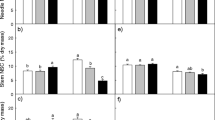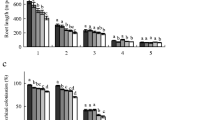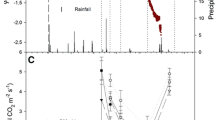Abstract
Rising atmospheric carbon dioxide, nitrogen deposition and warmer temperatures may alter the quantity and quality of plant-derived organic matter available to soil biota, potentially altering rates of belowground herbivory and decomposition. Our objective was to simulate future growth conditions for an early successional (loblolly) and late successional (ponderosa) species of pine to determine if the physical and chemical properties of the root systems would change. Seedlings were grown for 160 days in greenhouses at the Duke University Phytotron at 35 or 70 Pa CO2 partial pressure, ambient or ambient + 5 °C temperature, and 1 or 5 mMNH4O3. Roots from harvested seedlings were analyzed for changes in surface area, specific root length, mass, total nonstructural carbohydrates (TNC), and concentrations of macro-nutrients. Surface area increased in both species under elevated CO2, due primarily to increases in root length, and this response was greatest (+138%) in loblolly pine at high temperature. Specific root length decreased in loblolly pine at elevated CO2 but increases in mass more than compensated for this, resulting in net increases in total length. TNC was unaffected and nutrient concentrations decreased only slightly at elevated CO2, possibly from anatomical changes to the root tissues. We conclude that future growth conditions will enhance soil exploration by some species of pine, but root carbohydrate levels and nutrient concentrations will not be greatly affected, leaving rates of root herbivory and decomposition unaltered.
Similar content being viewed by others
References
Allen H L, Dougherty P M and Campbell R G 1990 Manipulation of water and nutrients-Practice and opportunity in Southern U.S. pine forests. For. Ecol. Manage. 30, 437–453.
Arnone J A and Körner C 1995 Soil and biomass carbon pools in model communities of tropical plants under elevated CO2. Oecologia 104, 61–71.
Arp, W J 1991 Effects of source-sink relations on photosynthetic acclimation to elevated CO2. Plant Cell Environ. 14, 869–875.
Baker J B and Langdon O G 1990 Pinus taeda L., loblolly pine. In Silvics of North America, Volume l, Conifers. Eds. R M B Burns and B H Honkala. pp 497–512. USDA Forest Service Handbook Number 654, Washington D.C.
Bassman J H 1988 Photosynthesis and water relations of ponderosa pine. ln Ponderosa Pine. The Species and its Management. Eds. D M Baumgartner and J E Lotan. pp 45–58. Washington State University Press, Pullman, WA.
Bernston G M and Woodward F I 1992 The root system architecture and development of Senecio vulgaris in elevated CO2 and drought. Func. Ecol. 6, 324–333.
Bormann F H and Likens G E 1979 Pattern and process in a forested ecosystem. Disturbance, development and the steady state based on the Hubbard Brook ecosystem study. Springer-Verlag, New York. 253 p.
Coleman I S, McConnaughay K D M and Bazzaz F A 1993 Elevated CO2 and plant nitrogen-use: Is reduced tissue nitrogen concentration size-dependent? Oecologia 93, 195–200.
Cotufro M F, Ineson P and Rowland A P 1994 Decomposition of tree leaf litters grown under elevated CO2: Effect of litter quality. Plant Soil 163, 121–130.
Cox T L, Hams W F, Ausmus B S and Edwards N T 1978 The role of roots in biogeochemical cycles in an eastern deciduous forest. Pedobiolobia Bd. S, 264– 271.
Curtis P S, O'Neill E G, Teeri J A, Zak D R and Pregitzer K S 1994 Belowground responses to rising atmospheric CO2: Implications for plants soil biota and ecosystem processes. Plant Soil 165, 1–6.
Diaz S, Grime J P, Harris and McPherson E 1993 Evidernce of a feedback mechanism limiting plant response to elevated carbon dioxide. Nature 364, 616–617.
Dubois M, Giles K A, Hamilton J K, Rebers P R and Smith F 1956 Calorimetric method for determination of sugars and related substances. Anal. Chem. 28, 350–356.
Galloway J N, Schlesinger W H, Levy II H, Michaels A and Schnoor J L 1995 Nitrogen fixation: Anthropogenic enhancementenvironmental response. Glob. Biogeochem. Cycles 9, 235–252.
Gebauer R L E, Reynolds, J F and Strain B R 1996 Allometric relations and growth in Pinus taeda: the effect of elevated CO2 and changing N availability. New Phytol. 134, 85–93.
Griffin K L, Winner W E and Strain B R 1995 Growth and drymatter partitioning in loblolly and ponderosa pine seedlings in response to carbon and nitrogen availability. New Phytol. 129, 547–556.
Hellmers H znd Giles L J 1979 Carbon dioxide: critique I. In Controlled Environment Guidelines for Plant Research. Eds. T W Tibbits and T T Kozlowski. pp 229–234. Academic Press, New York.
IPCC 1996 Climate change 1995: the science of climate change. Contribution of Working Group 1 to the Second Assessment Report of the Intergovernmental Panel on Climate Change. Cambridge University Press, Cambridge. 572 p.
King J S, Thomas R B and Strain B R 1996 Growth and carbon accumulation in root systems of Pinus taeda L. and Pinus ponderosa Dougl ex Laws seedlings as affected by varying CO2, temperature, and nitrogen. Tree Physiol. 16, 635–642.
Kramer P J 1981 Carbon dioxide concentration, photosynthesis, and dry matter production. BioScience 31, 29–33.
Kramer P J and Boyer J S 1995 Water relations of plants and soils. Academic Press, San Diego. 495 p.
Kramer P J, Hellmers H and Downs R J 1970 SEPEL: New phytotrons for environmental research. BioScience 20, 1201–1208.
Kuehny J S, Peet M M, Nelson P V and Willits D H 1991 Nutrient dilution by starch in CO2-enriched Chrysanthemum J. Exp. Bot. 42, 711–716.
Lambers H 1993 Rising CO2, secondary plant metabolism, plant-herbivore interactions and litter decomposition. Vegetatio 104/105, 263–271.
Larigauderie A Reynolds J F and Strain B R 1994 Root response to CO2 enrichment and nitrogen supply in loblolly pine. Plant Soil 165, 21–32.
Lincoln D E 1993 The influence of plant carbon dioxide and nutrient supply on susceptibility to insect herbivores. Vegetatio 104/105, 273–280.
Lowther J R 1980 Use of a single sulfuric acid and hydrogen peroxide digest for the analysis of Pinus radiata needles. Commun. Soil Sci. Plant Anal. 1l, 115–188.
Mac Fall J S, Johnson G A and Kramer P J 1991 Comparative water uptake by roots of different ages in seedlings of loblolly pine (Pinus taeda L.). New Phytol. 119, 551–560.
Marschner H 1995 Mineral nutrition of higher plants. Academic Press, London. 889 p.
Marx D H 1971 Tree host range and world distribution of the ectomycorrhizal fungus Pisolithus tinctorius Can. J. IVZcrobiol. 23, 217–223.
Nambiar E K S 1987 Do nutrients retranslocate from fine roots? Can. J. For. Res. 17, 913–918.
Norby R J 1994 Issues and perspectives for investigating root responses to elevated atmospheric carbon dioxide. Plant Soil 165, 9–20.
Norby R J, 0'Neill and Luxmoore R J 1986 Effects of atmospheric CO2 enrichment on the growth and mineral nutrition of Quercus alba in nutrient-poor soil. Plant Physiol. 82, 83–89.
Oliver W W and Ryker R A 1990 Pinus ponderosa Dougl. ex Laws., Ponderosa pine. In Silvics ofNorth America, Volume 1, Conifers. Edg. R M Burns and B H Honkala. pp 413–424. USDA Forest Service Handbook Number 654, Washington, D.C.
O'Neill E G 1994 Responses of soil biota to elevated atmospheric carbon dioxide. Plant Soil 165, 55–65.
O'Neill E G and Norby R J 1996 Litter quality and decomposition rates of foliar litter produced under CO2 enrichment. In Carbon dioxide and terrestrial ecosystems. Eds. G W Koch and H A Mooney. pp 87–103. Academic Press, Inc., San Diego.
Overdieck D 1993 Elevated CO2 and the mineral content of herbaceous and woody plants Vegetatio 104/105, 403–411.
Radoglou K M and Jarvis P G 1990 Effects of CO2 on four popular clones. I. Growth and leaf anatomy. Am. Bot. 65, 611–626.
Rogers H H, Prior S A and O'Neil1 E G 1992 Cotton root and rhizosphere responses to free-airCO2 enrichment. Crit. Rev. Plant Sci. 11, 251–263.
SAS Institute, Inc 1988 SAS/STAT User's Guide, Release 6.03 Edition. SAS Cary, NC. 1028p.
Schlesinger W H 1991 Biogeochemistry: An analysis of global change. Academic Press, San Diego. 443 p.
Shaw G R 1914 The genus Pinus. Arnold Arboretum Publ. No. 5, Cambridge, MA. 96p.
Steel R G D and Torrie J H 1980 Principles and procedures of statistics: a biometrical approach. McGraw-Hill, New York. 633 p.
Strain B R and Cure J D 1985 Direct effects of increasing carbon dioxide on vegetation. The Office of Energy Research. U.S. Dept. of Energy. DOE/ER–0238. 286 p.
Thomas J F and Harvey C N 1983 Leaf anatomy of four species grown under continuous CO2 enrichment. Bot. Gaz. 144, 303– 309.
Thomas R B and Strain B R 1991 Root restriction as a factor in photosynthetic acclimation of cotton seedlings grown in elevated carbon dioxide. Plant Physiol 96, 621–634.
Tissue D T, Griffin K L, Thomas R B and Strain B R 1995 Effects of low and elevated CO2 on C3 and C4, annuals. II. Photosynthesis and leaf biochemistry. Oecologia 01, 21–28.
Tissue D T and Wright S J 1995 Effect of water availability on phenology and the annual shoot carbohydrate cycle of tropical forest shrubs. Funct. Ecol 9, 518–527.
Tschaplinski T J, Norby R J, and Wallschleger T J 1993 Responses of loblolly pine seedlings to elevated CO2 and fluctuating water supply. Tree Physol. 13, 283–296.
Wahlenberg W G 1960 loblolly pine: Its use, ecology, regeneration protection, growth, and management. Duke University, School of Forestry, Durham, NC. 603 p.
Waring, R H and Schlesinger W H 1985 Forest Ecosystems: Concepts and management. Academic Press, San Diego. 340 p.
Williams R S, Lincoln and Thomas R B 1994 Loblolly pine grown under elevated CO2 affects early instar pine sawfly performance. Oecologia 98, 64–71.
Williams W E, Garbutt K, Bazzaz F A and Vitousek P M 1986 The response of plants to elevated CO2. IV. Two deciduous-forest tree commuunities, Oecologia 69, 454–459.
Wong S C 1990 Elevated atmospheric partial pressure of CO2 and plant growth II. Nonstructural carbohydrate content in cotton plants and its effect on growth parameters. Photosyn. Res. 23, 171–180.
Zak D R, Pregitzer K S, Curtis P S, Teeri J A, Fogel R F and Randlett D L 1993 Elevated atmospheric CO2 and feedback between carbon and nitrogen cycles. Plant Soil 151, 105–117.
Author information
Authors and Affiliations
Rights and permissions
About this article
Cite this article
King, J., Thomas, R. & Strain, B. Morphology and tissue quality of seedling root systems of Pinus taeda and Pinus ponderosa as affected by varying CO2, temperature, and nitrogen. Plant and Soil 195, 107–119 (1997). https://doi.org/10.1023/A:1004291430748
Issue Date:
DOI: https://doi.org/10.1023/A:1004291430748




